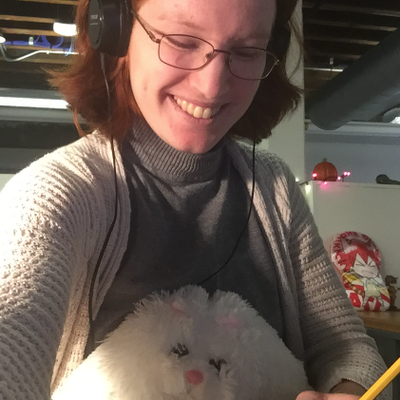![]() PIXEL-SHOT/SHUTTERSTOCK
PIXEL-SHOT/SHUTTERSTOCK
Natalie Linn has lived with chronic pain since she was in first grade. Her flares all but disappeared for a decade then came back. Now 24, the Albuquerque, New Mexico, resident only recently found a real and reliable way to treat the pain.
Why did it take so long?
“The doctors have been hell,” she said. “Before this flare started, I never understood why people who could go to the doctor would choose not to. Holy cow — now I know. It’s such a horribly infantilizing, invalidating, invasive experience to sit down in front of yet another glassy-eyed doctor, drop your life into their lap and have them ask you yet again whether you’re aware of ‘the strange ways stress can affect the human body.’ I’d come to these emergency clinics in horrible pain and the lack of empathy … it’s really something. The doctors looked at me like bored customer service associates.”
 Unfortunately, Linn’s experiences are common. It can be difficult for young people to convince health care providers of their chronic pain.
Unfortunately, Linn’s experiences are common. It can be difficult for young people to convince health care providers of their chronic pain.
Dr. Lonnie Zeltzer created the UCLA Pediatric Pain Clinic to treat children and adolescents with chronic pain. She later launched Whole Child LA, a provider of integrative mind-body treatment for children suffering pain, stress and other disabling conditions, where she is co-director with her husband, Dr. Paul M. Zeltzer.
As the Zeltzers write in the introduction to their book “Pain in Children and Young Adults: The Journey Back to Normal,” “It constantly amazes us that children who have chronic pain for long periods of time and who have gone through so many evaluations by different sub-specialists and diagnostic tests and treatments, have conditions that seem fairly easy to understand and treat … if the right framework is used and the right questions are asked.”
One in 5 children in this country is suffering from some form of chronic pain, the Zeltzers say. And this has wide-ranging repercussions, as it can affect school attendance, academics, social activities, sleep and all-around functioning.
Doctors discount young people
Linn has either interstitial cystitis or vulvodynia. Since these are “process of elimination” conditions, she likely would have had to go through another year of testing for an official diagnosis. Her main symptom is vaginal burning. She describes the feeling as being as if someone took a hot branding iron and shoved it against your genitals. Some days the “branding iron” barely brushes her skin, to the point that she can forget it’s there.

Courtesy of Natalie Linn
Natalie Linn
Urinating stings, burns or feels like passing crushed glass. At least, that was the case until she finally figured out that her pain is related to her diet. None of her doctors had ever suggested she try an elimination diet. If she hadn’t done her own research, she has no idea how long it would have taken to find relief.
In a Facebook group for inflammatory bowel disease in older teens and younger adults, there are many stories of doctors discounting young people’s pain. One mother reported that when her daughter complained of stomach pain, the pediatrician said she just didn’t want to go to school. When she was finally diagnosed with Crohn’s disease, she was so malnourished she had fractures throughout her spine.
Elizabeth Wagner, of Berkeley Lake, Georgia, has a 19-year-old son who was diagnosed with Crohn’s three years ago but is still struggling with abdominal pain. After his doctor — part of a go-to group for pediatric gastrointestinal doctors in Atlanta — told him he’d have to learn to live with the pain, they left. After being given high-dose medicine and nerve blocks, a pain clinic doctor elsewhere ultimately told him there were no options left other than to send him to an out-of-state pain clinic to learn how to live with the pain. Meanwhile, the pain was bad enough that he couldn’t go to school or work, nor could he eat or function.
“Since the doctors could find nothing and his ‘numbers’ were fine, he was diagnosed with visceral hypersensitivity,” Wagner said.
At every follow-up exam, her son gasped in pain when the doctor pressed on his lower right abdomen. When she questioned this, she was told his brain perceived the pain as worse than it was. The pain psychologist even told her she was doing her son more harm than good by continuing to research. She finally got fed up and made an appointment at the Mayo Clinic.
“It took a test that lasted less than an hour and a brief physical exam to diagnose my son with pelvic floor dysfunction,” Wagner recalled. “A follow-up CT showed my son had a large stool impaction in the area of his terminal ileum — exactly where his doctor pressed upon in the routine exam. The earliest MRI showed this impacted material and it was noted on follow-up MRIs, yet none of his doctors ever considered it as an issue.”
She believes the time the Mayo doctor took to speak with her son made a difference.
“Never, never give up!” Wagner said. “What if I had given up? That is the part that truly scares me. Trusting a doctor and sentencing my son to a lifetime of pain.”
Chronic pain is difficult, unpredictable, complex
So why is it so difficult to convince these health care providers? “Because of their age, we assume that they should not have pain,” Penney Cowan, CEO and founder of the American Chronic Pain Association, said. “Too often they are written off as growing pains or something they will simply get over. They have never been trained to recognize and/or treat kids in pain.”
Children are also considered less reliable than adults when it comes to reporting pain, the Zeltzers write. Providers also need to realize that if they can’t find the cause of the pain, it doesn’t mean it’s in their head. Children also tend to be undertreated, especially for acute pain.
“I feel like my age was absolutely part of what caused the doctors to diagnose me with ‘stress’ over and over,” Linn said. “There’s always that persistent mentality of ‘You’re too young to be chronically ill.’”
Patients and their loved ones may need to take matters into their own hands. The most obvious first step: If the health care provider doesn’t believe in the young person’s chronic pain, find someone else. Ideally, this person would be someone who practices holistic medicine.
The Zeltzers suggest asking that provider if they have experience dealing with pain problems in children or adolescents.
“Health care providers need to finally accept the reality that young chronically ill people are pretty damn common,” Linn said. “It absolutely kills me to think of all the young people like me who will have to endure horrible pain for years because health care providers won’t take them seriously.”































